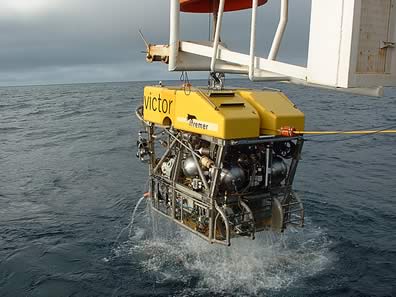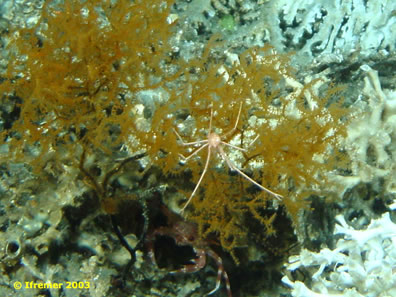
| Accommodation
|
What's On?
|
Travel
|
Webcams
Classified Ads | Local News | Photo Gallery | History Galway Arts Festival 2004 |
Polar Research Vessel Unveils Coral Paradise in Irish WatersPolar Research Vessel Unveils Coral Paradise in Irish Waters The German polar research vessel, Polarstern, will visit Ireland for the first time on Friday 20th June 2003. The 118m long icebreaker is being used to support remotely operated vehicle dives with the French remotely operated vehicle 'VICTOR'. A series of eight dives are being carried out in the Porcupine Seabight and west of the Porcupine Bank in Irish waters to map deep-water corals, carbonate mounds and interesting geological features. Over 40 marine scientists from Ireland, Belgium, the UK, France and Germany are participating. They have completed an intensive study program on Irish coral locations using VICTOR, an unmanned deep-sea robot that can dive to 6000 m water depth, with a weight of four tons and with remotely operated cameras and manipulators that allow the collection of samples and data with unprecedented precision. Weather conditions over the last few weeks would have seriously curtailed the dive programme on a smaller ship. However, the Polarstern permitted a series of dives to take place. More than 100 hours of high-resolution video have been shot on the seafloor and many samples collected over more than 100 square km of seafloor. Between dives systematic surveys have been conducted by means of grabs, multicorer (precision sediment sampler), CTD (water profiler) and ship borne sonar systems mounted on the Polarstern. The expedition began in Brest, France on June 2nd, 2003 where more than 100 tons of VICTOR equipment was installed. This is the second time VICTOR has been deployed from the Polarstern and the third time it has been used by international working groups under the framework of closer and more formal French-German cooperation in polar and marine sciences. The Irish participants of this expedition come from marine research institutes in the Universities of Cork, Dublin and Galway and the Geological Survey of Ireland. "A number of the Irish participants are veterans of the IFREMER lead cruise studying Irish deep-water corals in 2001 and their expertise was invaluable during the current expedition" says Dr. Jörn Thiede, Professor at Alfred-Wegener-Institute (AWI) for Polar and Marine Research, Germany, and chief scientist on the expedition.  "The North-East Atlantic to the west of Ireland is a treasure chest for new ocean discoveries," explains Dr. Thiede. "Several hundred metre high submarine carbonate mounds topped with coral reefs are part of these largely unexplored treasures. They occur in a narrow depth range between 500 and 1000 m water depth along a belt trailing the entire west European continental margin, from the Bay of Biscay to the Barents Sea in the Arctic. Deepwater corals were already known to Irish, English and Norwegian fishermen as well marine biologists over 100 years ago, as they were repeatedly taken in their catches." Lophelia pertusa, the major framework constructing coral of these habitats, has adapted to the cold, deep and dark living conditions found at these depths off the west coast of Ireland. A unique feature of Irish corals is their contribution to the growth of carbonate mound 'bioherms' - underwater hills up to 300m in height composed of coral skeletons and sediments. These mounds occur in high numbers along the margins of the Irish Porcupine Seabight and Porcupine Bank. Scientists have estimated that approximately 60% of the European deep-water coral occurrences are located off Ireland. Modern geophysical surveys detected these large structures under the surface of the seafloor and helped to define the geometry of the mound-like structures that have been frequently found deeply buried under a sediment cover. They form extensive sediment bodies and structures with high porosities at great depth and they are therefore of interest not only for the academic scientists, but also for the hydrocarbon industry hunting for potential reservoirs in the deep ocean. Coral reefs are typical for tropical ocean regions where they assemble rich communities of benthic organisms just below the sea surface and where they are under the influence of sunlight develop a high biological activity and fast turnover of nutrients. How and when reefs developed in the cool, deep and dark bottom waters over the Porcupine Seabight and Porcupine Bank and how they exist there under modern conditions is not fully resolved. Their origin can be found in fossils preserved in relatively old geological deposits. Related Links
|